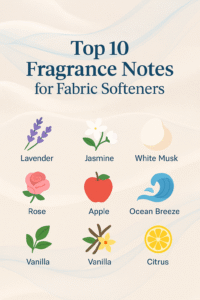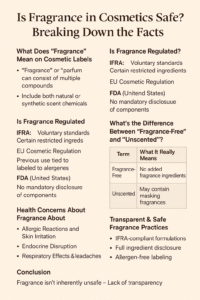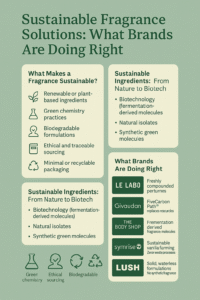The Scent of Success: How Fragrance Fuels Detergent Companies’ Triumph
Fragrance is more than just a pleasant smell; it’s a powerful tool that can shape consumer preferences, build brand identities, and ultimately drive sales. In the competitive world of laundry detergents, the right scent can elevate a product from ordinary to unforgettable. This article explores the essential role of fragrance in detergent companies’ success, examining consumer behavior, industry innovations, and emotional connections that fragrances create.
Introduction
The Power of Fragrance in Detergent Brands
In a market flooded with options, the scent of a detergent can be a distinguishing factor. A well-chosen fragrance not only enhances the cleaning experience but also makes the product memorable. Brands like Tide and Persil have effectively leveraged scent to foster customer loyalty and differentiate themselves from competitors.
Understanding Consumer Behavior Towards Scented Products
Consumer preferences are heavily influenced by scent. Research shows that fragrances can evoke memories and emotions, leading consumers to associate specific scents with cleanliness and freshness. This psychological connection is vital for brands aiming to create lasting impressions in consumers’ minds.
The Role of Fragrance in Detergents
Building Brand Identity Through Scent
Fragrance plays a critical role in establishing a brand’s identity. For example, Downy’s signature “April Fresh” scent has become synonymous with the brand, creating a recognizable olfactory signature. Such identity helps brands foster loyalty as consumers often choose products based on familiar scents.
Fragrance as a Marketing Tool
Effective marketing campaigns utilize fragrance to evoke specific emotions. Advertisements often emphasize the sensory experience of using the product, appealing to consumers’ desires for comfort and cleanliness. Brands frequently highlight scent benefits in their messaging, positioning their products as a key to a pleasant laundry experience.
The Science Behind Fragrance Selection
The selection of fragrances is not arbitrary; it involves extensive research and testing. Companies often employ scent experts and conduct focus groups to determine which fragrances resonate best with their target audience. The goal is to create scents that evoke positive associations, enhancing the product’s overall appeal.
Industry Innovations
Technological Advancements in Fragrance Development
Recent technological advancements have revolutionized fragrance development. Innovations like microencapsulation allow scents to be released gradually during washing and wearing, ensuring longer-lasting freshness. This technology not only enhances user experience but also helps brands stand out in a crowded market.
Sustainable Practices in Scent Creation
With increasing consumer demand for sustainability, many brands are focusing on eco-friendly fragrance options. Companies are turning to natural ingredients and biodegradable scent compounds to reduce their environmental impact. This shift not only aligns with consumer values but also helps brands build a positive image.
Case Studies: Leading the Way with Fragrance
Brands like Method and Seventh Generation have successfully integrated sustainable practices in their fragrance development. By using plant-derived ingredients, they not only appeal to eco-conscious consumers but also set industry standards for sustainable product offerings.
Consumer Preferences
Trends in Fragrance Types and Preferences
Consumer preferences for laundry detergent fragrances are evolving. While classic scents like fresh linen remain popular, there is a growing demand for exotic and unique fragrance blends. Ingredients such as coconut and jasmine are gaining traction as consumers seek more adventurous scent profiles.
Cultural Influences on Fragrance Choice
Cultural backgrounds significantly influence fragrance preferences. For instance, consumers in different regions may favor floral or citrus scents based on local customs and traditions. Understanding these cultural nuances is essential for brands aiming to connect with diverse audiences.
The Impact of Social Media on Fragrance Fame
Social media has become a driving force in fragrance popularity. Platforms like Instagram and TikTok allow consumers to share their experiences with different scents, creating trends and influencing purchasing decisions. Brands that effectively leverage social media can boost their fragrance’s visibility and appeal.
The Emotional Connection
Fragrance and Memory: A Nostalgic Tie
Fragrance has a powerful link to memory. Scents can transport consumers back to specific moments in time, evoking feelings of nostalgia. This emotional connection enhances brand loyalty, as consumers often gravitate toward products that remind them of comforting experiences.
Psychology of Scent: Feeling Clean and Fresh
The psychology of scent plays a critical role in consumer perceptions of cleanliness. Research indicates that certain scents can trigger feelings of freshness and cleanliness, making consumers more likely to choose those products. Brands that understand this connection can craft fragrances that align with their marketing messages.
Creating a Multi-Sensorial Experience
Successful detergent brands recognize the importance of creating a multi-sensorial experience. This includes not just the scent but also the visual presentation, packaging, and tactile elements. By engaging multiple senses, brands can leave a lasting impression on consumers.
Product Development
Formulating Long-Lasting Fragrances
Developing long-lasting fragrances is a key challenge for detergent companies. Brands invest in research to create scents that withstand the rigors of washing and wearing. Innovations in formulation techniques, such as using encapsulated fragrance technology, are crucial in achieving this goal.
Challenges in Maintaining Scent Integrity
Maintaining fragrance integrity throughout the product lifecycle is essential. Factors like temperature fluctuations and exposure to air can alter scents over time. Brands must focus on packaging solutions that protect fragrance integrity while ensuring a pleasant user experience.
Innovations in Natural and Organic Fragrances
As consumer interest in natural and organic products rises, detergent companies are responding with innovative fragrance solutions. Natural fragrances, derived from essential oils and plant extracts, are gaining popularity as consumers seek safer and more environmentally friendly options.
Market Strategy
Segmentation and Targeting Based on Scent Preferences
Understanding scent preferences allows brands to segment their markets effectively. By analyzing consumer behavior and preferences, companies can target specific demographics with tailored marketing strategies, ensuring that their products resonate with the intended audience.
Packaging and Presentation: The First Scent Encounter
Packaging plays a vital role in the first encounter with a fragrance. Attractive and informative packaging can entice consumers, while functional design can enhance the product experience. Brands must balance aesthetics with practicality to create appealing packaging that draws consumers in.
Online vs. In-Store: Selling the Scent Unseen
The retail landscape is evolving, with more consumers shopping online. This shift presents challenges for fragrance-based products, as scent cannot be experienced until after purchase. Brands are exploring innovative solutions, such as scent sampling kits and olfactory marketing strategies, to bridge this gap.
Success Stories & Failures
Analyzing Successes: What Worked and Why
Success stories in the detergent industry often highlight the importance of scent. Brands that effectively align fragrance with consumer preferences, such as Gain with its signature scents, demonstrate the power of fragrance in driving sales and brand loyalty.
Learning from Failures: When Fragrances Don’t Resonate
Not all fragrance choices lead to success. Brands that miss the mark on scent selection can face backlash. Analyzing failures provides valuable insights into consumer preferences, helping companies avoid costly missteps in the future.
Regulatory and Environmental Considerations
Navigating Regulations on Fragrance Ingredients
Regulatory frameworks around fragrance ingredients are becoming increasingly stringent. Brands must navigate these regulations to ensure compliance while maintaining product effectiveness. Transparency in ingredient sourcing and formulation is essential to build consumer trust.
Eco-Friendly Fragrances: A Growing Demand
The demand for eco-friendly fragrances is on the rise, driven by consumer awareness of environmental issues. Brands that prioritize sustainability in their fragrance offerings can differentiate themselves in a competitive market and resonate with eco-conscious consumers.
The Future of Fragrance in Detergents
Emerging Trends in Fragrance Development
As consumer preferences continue to evolve, new trends in fragrance development are emerging. Brands are exploring innovative scent combinations, sustainable sourcing, and technology-driven solutions to meet changing demands.
The Role of AI and Machine Learning in Scent Creation
The use of AI and machine learning in fragrance creation is a burgeoning trend. These technologies can analyze consumer data to identify preferences and predict successful scent combinations. As brands adopt these advanced tools, we can expect more tailored and appealing fragrances in the market.
Summary
The enduring value of fragrance in the detergent industry cannot be overstated. From shaping brand identities to influencing consumer behavior, scent plays a pivotal role in market success. Brands that embrace innovation, sustainability, and consumer preferences are well-positioned to thrive in the competitive landscape.
Key Takeaways on Scent’s Role in Market Success
- Fragrance is a powerful marketing tool that shapes brand identity and consumer loyalty.
- Technological advancements are enhancing fragrance development and sustainability.
- Understanding consumer preferences and emotional connections to scent is crucial for success.
- Brands must navigate regulatory landscapes while responding to the growing demand for eco-friendly options.
FAQs
- How do companies choose fragrances for detergents? Companies conduct extensive research and testing, utilizing focus groups and scent experts to determine which fragrances resonate with consumers.
- Can fragrances in detergents affect skin sensitivity? Yes, some individuals may be sensitive to certain fragrance ingredients, leading to skin irritation. Brands often provide ingredient lists to help consumers make informed choices.
- What is the most popular detergent fragrance? Popular fragrances vary by region, but fresh linen and lavender are consistently favored among consumers for their associations with cleanliness.
- Are natural and organic fragrances better than synthetics? Natural fragrances are often perceived as safer and more environmentally friendly, but effectiveness can vary. Consumer preference plays a significant role in this debate.
- How can consumers find their ideal detergent fragrance? Experimenting with different products and reading reviews can help consumers identify fragrances that align with their personal preferences. Brands that offer sampling options can also aid in this process.



